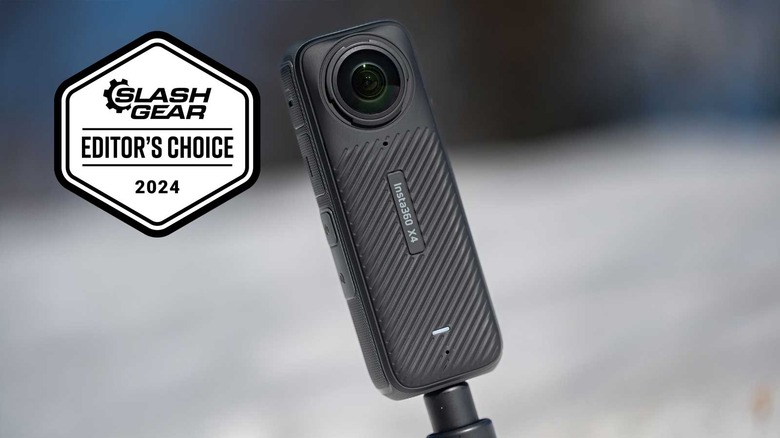
Andy Zahn/SlashGear
By Andy Zahn/
EDITORS’ RATING : 9 / 10
- 8K 360 video recording
- 11K 360 timelapse recording
- Improved slow motion capability
- Impressive battery life
- Waterproof and more rugged than the X3
- Gesture control
- Upgraded editing software on mobile and PC
- More expensive
- Gets very hot when recording 8K video and 11K timelapse
- Necessary to lower resolution when shooting in low light
A 360 camera can be an awesome tool for filmmakers, and the Insta360 X4 takes the concept a huge step forward, at least on paper. Video resolution has long been the stumbling block for mainstream, affordable 360 cameras, which is why it’s so exciting to see Insta360 finally bump the maximum resolution of its flagship X-series lineup to 8K, though that leaves a big question of how good that 8K actually looks.
On top of this, the X4 appears to be a serious upgrade in practically every other respect compared to the X3, which I have quite enjoyed using since its launch. The X3 was itself a big improvement over its predecessor, the X2, and Insta360 has consistently led the 360 camera market for some time now. However, even with the X3, I felt we were still a generation away from a 360 camera that could be as versatile and powerful as this type of camera promises to be, and the X4 might just be the 360 camera I’ve been chasing for years now. Insta360 provided a sample of the X4 for this review.
8K gets 360-video where it needs to be
My major problem with shooting 360 video has previously been primarily the limited resolution. Even shooting 5.7k with the Insta360 X3 was good for some applications, but only just barely acceptable for others. The Insta360 X4 brings a very welcome upgrade to 8K resolution, and immediately upon importing the footage onto my computer and viewing it on the big screen, I could tell just how significant that upgrade is. Where before a complex forest environment might have been muddled by lack of resolution, the X4 manages to render such scenarios with remarkable clarity when shooting at 8K.
The X4 also handles situations with high contrast much more aptly, so I had much less of an issue with blown-out highlights or crushed shadows. Even when you drop down to 5.7k or 4k to shoot slow-motion footage, or to capture video in low-light scenarios, the X4 delivers very good results. I took the X4 into a theater to record a live performance at 5.7k 30fps, and while this was an extremely challenging environment, and there was some detail lost in this extreme high-contrast environment, the result is nonetheless surprisingly good. 4K 100fps slow motion was also shockingly good looking when I tested it out, and Bullet Time mode delivers 5.7K 120fps when combined with the optional Bullet Time Accessory Bundle.
11K timelapse shooting and 72MP still photos, and the lingering issues of 360 lenses/stitching
The X4 can even go all the way up to 11K when capturing timelapse videos, which is really exciting as it means you can record a 360-degree timelapse and select many individual crops out of it while maintaining good detail. Still photography is available with resolution up to an impressive 72MP. These photos look crisp and clear, thanks to Insta360’s Pureshot processing. It’s great to have so much resolution to play with in post-processing.

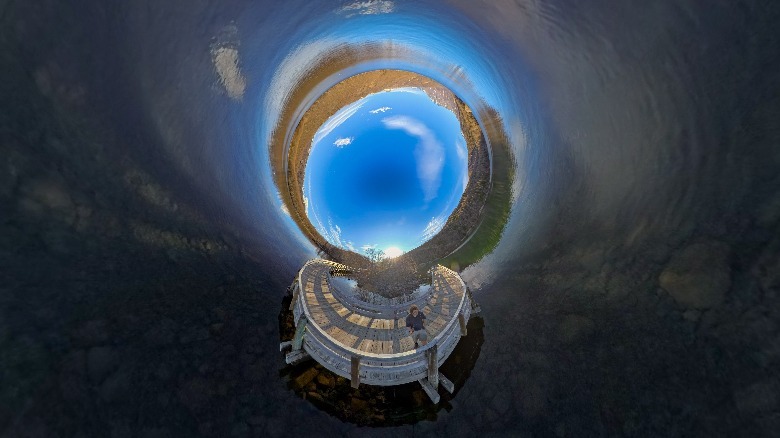
In some shots, I did still notice the line where the two cameras’ field of view are stitched together, but so long as you keep the lenses clean it does a very good job, for the most part, of presenting a seamless sphere. Flaring and exposure differences between the two sides of the camera were problems that did also rear their ugly heads, but not to a serious extent. All these problems are not serious issues, but rather factors inherent to 360 cameras that are less pronounced here than ever before in my experience.
Rugged and waterproof, but overheating is a concern
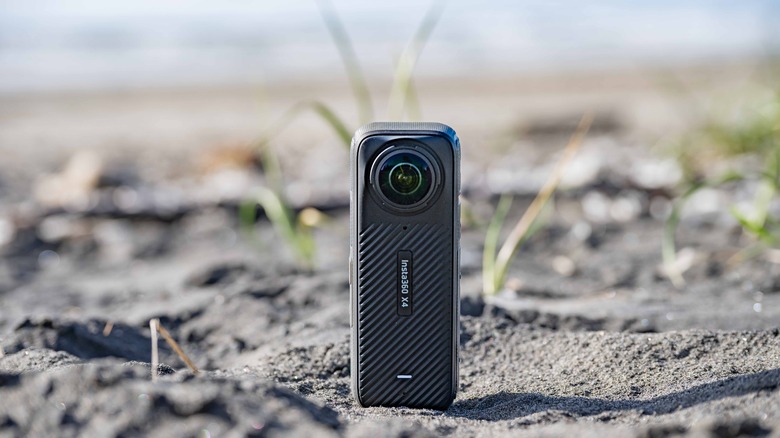
Andy Zahn/SlashGear
The Insta360 X4 is waterproof down to 33 feet underwater (to go further and actually film seamless 360 video you need a dive case), and features a very durable design. Key to this is the new removable lens guard system. These twist quickly and securely into place, and are a big improvement over the previous stick-on disposable lens guard system which I did not like at all. Bulbous 360 lenses are naturally vulnerable optics, and you really want to avoid scratches, so it’s great to have an extra layer of protection that’s easily attached and detached when using the camera in a potentially hazardous scenario, though the lens guards will still affect image quality to some extent.
The screen is large, bright, and now made from Corning Gorilla Glass, as opposed to the normal tempered glass of the Insta360 X3. This is a welcome change for me, as aside from the lenses, that’s the next most vulnerable point on the camera.
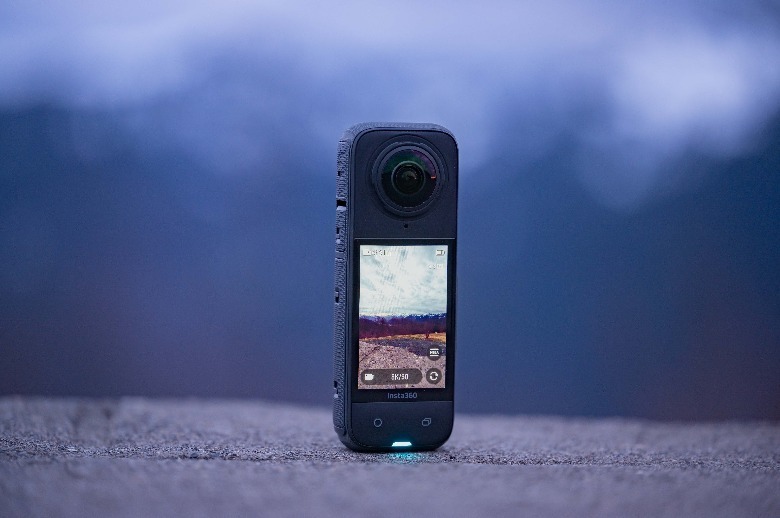
For ports, you have a USB-C port for charging and data transfer hidden behind a hatch, while the microSD card slot is located inside the battery compartment. Controls and the overall layout of the X4 is pretty much the same as the X3, though the X4 is now slightly larger and heavier with a nicely textured surface on the back that makes it easier to grip.
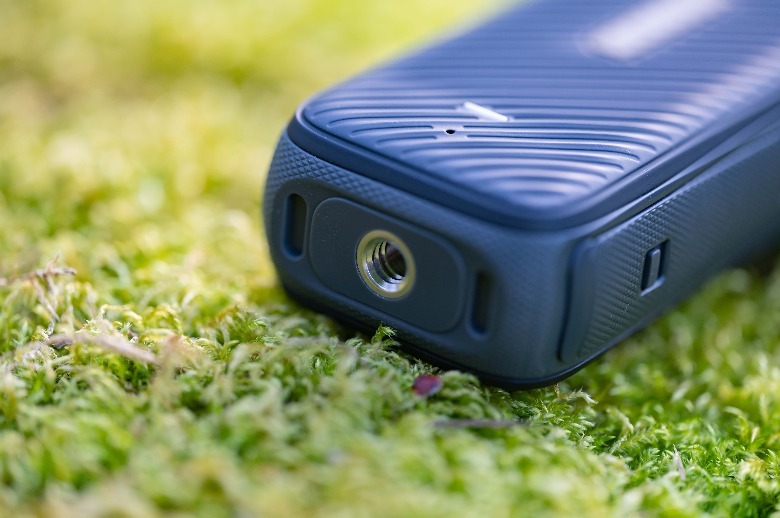
The downside of shooting 8K video and 11K timelapses is that the camera does get very hot while doing so. However, even after long filming sessions shooting in various conditions and at different resolutions, I never did get the X4 to shut down due to overheating. It did get quite toasty, however, so it might be an issue come summer.
Tremendously long battery life, and effective image stabilization
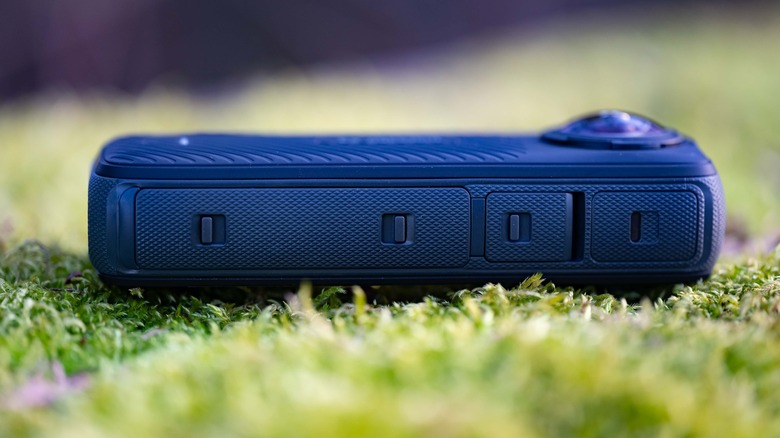
Andy Zahn/SlashGear
The Insta360 X4 purportedly boasts a 67% increase in run time versus its predecessor, with up to 135 minutes of recording time at 5.7K 30fps, or 75 minutes when filming at 8K 30fps. If anything, this is an understatement, as during a nearly hour-long recording of a live performance I only used up 44% of the battery. While I never fully drained it in a single recording session, I could see it achieving over 160 minutes of continuous recording at 5.7K 30fps. The upshot is that I never felt restricted by battery life when filming with the Insta360 X4.
Insta360’s Flowstate image stabilization is just as impressive as always in the X4, with it being able to deliver results as good or better than any other digital stabilization software. It produced consistently excellent results in a variety of scenarios, and sometimes achieved levels of stabilization comparable to a gimbal-equipped drone.
Software wizardry and improved microphones
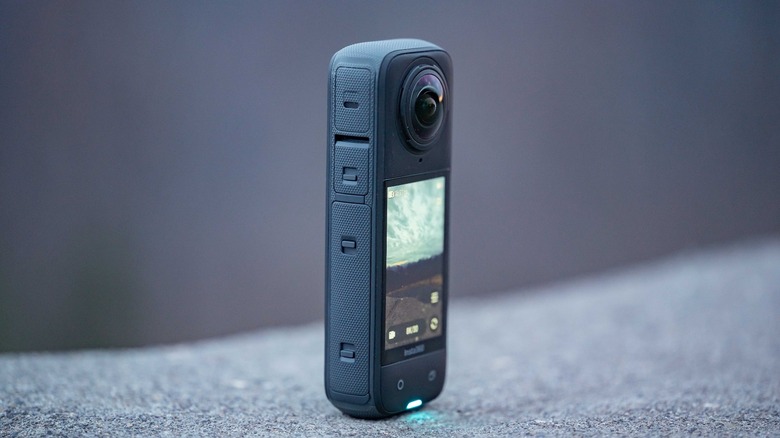
Andy Zahn/SlashGear
My primary attention when testing and evaluating the Insta360 X4 was focused on the hardware and the results it’s capable of delivering. However, that hardware is very deeply entwined with the software, and the high-quality experience with the camera was in large part due to how hard Insta360 has worked to refine its software, both in the camera and in the Android/IOS and desktop applications.
The in-camera menu navigation is slick and intuitive and has now been enhanced by AI-powered gesture and voice control. Those gestures are particularly useful when the camera is way out on the end of a 10-foot pole! The app now includes improved Quick Edit features to speed up post-processing, as well as a new AI editing function where the computer suggests edits for you. Manual editing capability is robust as always, as well as being fairly accessible to newcomers. I made good use of Motion ND, which helped add extra cinematic qualities to certain shots. An Adobe Premiere plugin is available in addition to the robust standalone desktop application.
The X4 now features some very high-quality mics that deliver excellent results that measure up well to current flagship action cameras. I would feel very comfortable filming content with this camera, even without an external mic, though it is also compatible with microphones such as the DJI Mic 2. I used it to record an orchestra, and the results were surprisingly decent.
Action camera killer?
One of the big selling points of the Insta360 X4 is that it’s not just a 360 camera, it’s also designed to fill the role of a traditional action camera with single-lens mode. It does so remarkably well, certainly much better than the X3, and to a point where it can go head-to-head with a GoPro and not fall too far behind. The X4 can shoot 4K at up to 60FPS, and it looks very good indeed. Its main weakness is in its slow motion capabilities, which are not as robust as those of a dedicated action camera, and something like an Insta360 Ace Pro, GoPro Hero 12 Black, or DJI Action 4 will still surpass it as an action camera.
However, taking into account the bigger picture where the X4 is an extremely capable and rugged 360 camera first, and a competent action camera second, the tradeoffs largely balance out. There’s still certainly good reason to own an action camera, but with the X4 the gap between 360 cameras and single-lens action cameras has closed significantly, at least until we see what the next generation of action cameras has in store.
Expensive, but worth the cost
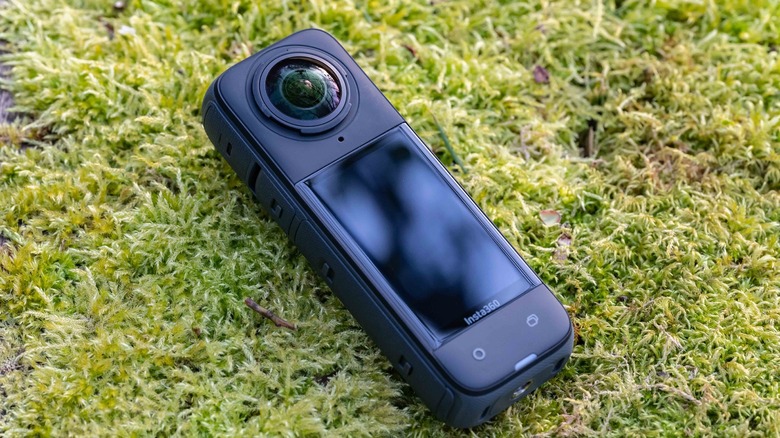
Andy Zahn/SlashGear
At $499.99, the Insta360 X4 is more expensive than its predecessor by $100. While the new camera is certainly far more capable, and certainly worth the extra cost, it does make it a more significant investment. It places the X4 at a higher price point than most action cameras, so a Hero 12, Action 4, or Ace Pro is going to be cheaper, but then those cameras aren’t 360 cameras, so it makes sense to pay a little more for the X4.
If you’re looking for a 360 camera with a larger sensor, the Insta360 One RS 1-inch is $300 more than the X4, and while that is still a better option for low light shooting, the X4’s 8K capability is a massive advantage in good light. There’s the aging GoPro Hero Max 360 camera, which is cheaper, but also lower resolution, and even the $800 Ricoh Theta X doesn’t offer 8K recording. Essentially, the previous Insta360 X3 stacked up well with the competition up till now, while the X4 surpasses them all by a significant margin.
Key accessories to consider

Andy Zahn/SlashGear
Insta360 included a few new accessories to test alongside the X4, and my favorite of them is the Extended Edition Selfie Stick, which is a whopping ten feet long, yet folds down into a remarkably compact form factor. Being able to send the Insta360 X4 up can deliver shots you’d normally need a drone to capture, just without the noise and regulatory hassle associated with drones. I ended up using this giant selfie stick for most of my time testing the X4, and I would almost regard it as an essential tool for creators working with 360 cameras. Being able to go up that high quite literally elevates your footage and opens up many exciting creative possibilities.
The somewhat niche, slightly terrifying, and very fun Bullet Time Accessory Bundle is designed to be used with the camera’s 5.7K 120fps slow-motion bullet time mode. The results this delivers are striking and the new system of a selfie stick attached to a rotating handle has definite advantages over the previous system, which used a retractable cord. It’s something of a one-trick pony, but it does create a unique effect that can be a compelling component of a video when well implemented.
There’s also a microSD card quick reader accessory available, as well as a dive housing, the latter being essential for seamless underwater 360-degree video stitching.
In the box, the X4 comes with standard lens guards (upgraded versions are available), a battery, thermo grip cover, USB Type-C cable, a protective pouch, and a lens cloth.
Conclusion
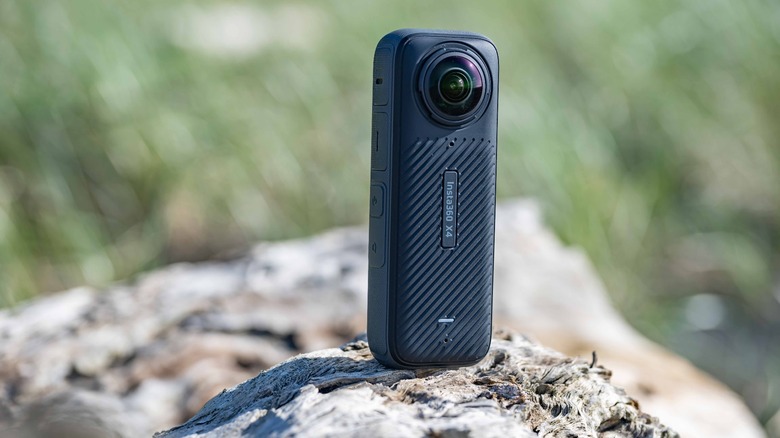
Andy Zahn/SlashGear
The Insta360 X4 is a huge step forward for 360 cameras. Shooting in 8K is just as revolutionary as I had hoped it would be, and truly this is where 8K video recording gains genuine utility to the average video creator. The extra sharpness is immediately noticeable, and it makes an enormous difference when post-processing footage, or when viewing footage in virtual reality. When viewing the even higher res 11K timelapse footage it’s easy to see where 360 camera technology is headed in the future, and to have the ability to shoot such imagery even now, albeit in timelapse form, is really exciting. This high-resolution capability trickles down to improved slow-motion filming, and really the big limitation to overcome now is low light, where currently you really do have to reduce your resolution and framerate down to more mundane levels.
On practically every level, the Insta360 X4 is a leap forward both for Insta360’s flagship line of 360 cameras and for mainstream 360 cameras in general. Once I’d finally sorted and edited the mountain of footage I captured with the X4 and put it together into a video, I was blown away by what I was able to create in a relatively short amount of time with the camera. If you’ve ever been interested in 360 photography or videography, now is the time to jump on board, and if you’re wondering if you should upgrade from your existing 360 camera, the answer is yes. I’ve never been able to so very easily recommend a 360 camera so enthusiastically as the Insta360 X4.
The Insta360 is available for $499.99 from Insta360’s online store.
